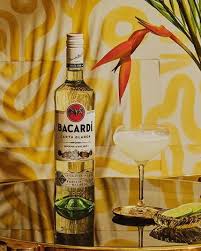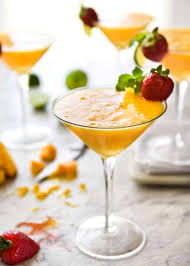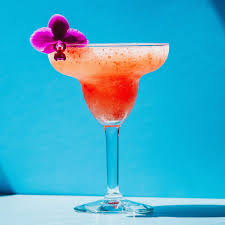
DAIQUIRI, MI MEJOR CÓCTEL Y SUS RECETAS MÁS FAMOSAS. VIDEOS/FOTOS.
El daiquirí es un cóctel cuyos ingredientes principales son ron, jugo de cítricos (generalmente jugo de lima) y azúcar u otro edulcorante.
RECETA.
50 ml de ron cubano ligero
25 ml de jugo de lima fresco
15 ml de jarabe de azúcar o su equivalente en forma granulada.
Agitar con hielo y colar en una copa de cóctel. Decorar con una rodaja de lima cortada y colocada en el borde de la copa.
El daiquirí es una de las seis bebidas básicas que aparecen en el clásico de David A. Embury, “El arte de mezclar bebidas”, que también incluye algunas variantes.
ORÍGENES
El nombre Daiquirí también es el nombre de una playa cerca de Santiago de Cuba y de una mina de hierro en esa zona, y es una palabra de origen taíno. El cóctel fue supuestamente inventado alrededor de 1900 en un bar llamado Venus en Santiago, a unos 37 km al este de la mina, por un grupo de ingenieros de minas estadounidenses. Entre los ingenieros presentes se encontraban Jennings Cox, gerente general de Spanish American Iron Co., J. Francis Linthicum, C. Manning Combs, George W. Pfeiffer, De Berneire Whitaker, C. Merritt Holmes y Proctor O. Persing. Aunque persisten las historias de que Cox inventó la bebida cuando se quedó sin ginebra mientras atendía a invitados estadounidenses, la bebida evolucionó de forma natural debido a la prevalencia de la lima y el azúcar.
Originalmente, la bebida se servía en un vaso alto con hielo picado. Se vertía una cucharadita de azúcar sobre el hielo y se exprimía el jugo de una o dos limas. Se añadían dos o tres onzas de ron para completar la mezcla. Luego, se glaseaba el vaso removiendo con una cuchara de mango largo. Posteriormente, el daiquirí evolucionó para mezclarse en una coctelera con los mismos ingredientes, pero con hielo raspado. Tras agitarlo bien, se vertió en una copa flauta fría. Un artículo publicado en la edición del 14 de marzo de 1937 del Miami Herald, así como la correspondencia privada de J.F. Linthicum, confirman la receta y su historia.
El consumo de la bebida se mantuvo en un lugar específico hasta 1909, cuando el almirante Lucius W. Johnson, oficial médico de la Marina de los EE. UU., probó la bebida de Cox. Posteriormente, Johnson la introdujo en el Club del Ejército y la Marina de Washington, D.C., y el número de bebedores de daiquirí aumentó en las siguientes décadas. El daiquirí fue una de las bebidas favoritas del escritor Ernest Hemingway y del presidente John F. Kennedy.
DAIQUIRI HEMINGWAY
60 ml de ron blanco (como DonQ Cristal)
0,75 ml de jugo de lima
1 cucharadita de marrasquino
1 cucharadita de jugo de toronja
1 cucharadita de azúcar
Agitar con hielo y colar en una copa de cóctel fría. Sirva frappé (hielo picado apilado en un vaso).
La bebida se popularizó en la década de 1940. El racionamiento durante la guerra dificultaba el acceso al whisky, el vodka, etc., pero gracias a la política de Buena Vecindad de Roosevelt (que abrió las relaciones comerciales y turísticas con Latinoamérica, Cuba y el Caribe), el ron era fácil de conseguir. La Política de Buena Vecindad (también conocida como el “Programa Panamericano”) contribuyó a que Latinoamérica se viera de moda. En consecuencia, las bebidas a base de ron (antes mal vistas por ser exclusivas de marineros y mendigos) también se pusieron de moda, y el daiquirí experimentó un enorme auge en popularidad en Estados Unidos.
Daiquirí helado
Una amplia variedad de bebidas alcohólicas mezcladas con hielo finamente pulverizado se conoce como daiquirí helado. Estas bebidas también se pueden combinar y servir en una licuadora, eliminando la necesidad de pulverizarlas manualmente y produciendo una textura similar a la de un batido. A mayor escala, estas bebidas suelen elaborarse comercialmente en máquinas más grandes y vienen en varios sabores con distintas bebidas alcohólicas o licores.[10] Otra forma de crear un daiquirí helado (principalmente variantes con sabor a frutas) es usando limonada helada, que aporta la textura, el dulzor y la acidez deseados a la vez.
Variaciones
Daiquirí de plátano: daiquirí normal con medio plátano.
Daiquirí de fresa: una bebida licuada de puré de fresas enteras, ron, azúcar de caña y jugo de lima.
DAIQUIRI DE LIMÓN
La receta básica de un daiquirí también es similar al grog que los marineros británicos bebían a bordo desde la década de 1740. Para 1795, la ración diaria de grog de la Marina Real Británica contenía ron, agua, ¾ de onza de jugo de limón o lima y 2 onzas de azúcar. Esta era una bebida común en todo el Caribe, y tan pronto como se dispuso de hielo, este se incluyó en lugar del agua. La historia de Jennings Cox es sin duda popular y tal vez él fue responsable del nombre de la bebida, pero en lo que respecta a su creación, llegó unos 150 años tarde.

DAIQUIRI, MY BEST COCKTAIL AND ITS MOST FAMOUS RECIPES. VIDEOS/ PHOTOS.
The daiquiri is a cocktail whose main ingredients are rum, citrus juice (typically lime juice), and sugar or other sweetener.
RECIPE.
50ml Light Cuban Rum
25ml Fresh Lime Juice
15ml Sugar Syrup, or the equivalent in granulated form.
Shake with ice, and then strain into a cocktail glass. Garnish with a lime wedge, which has been cut and then placed onto the rim of the glass.
The daiquiri is one of the six basic drinks listed in David A. Embury’s classic The Fine Art of Mixing Drinks, which also lists some variations.
ORIGINS
The name Daiquirí is also the name of a beach near Santiago, Cuba, and an iron mine in that area, and it is a word of Taíno origin. The cocktail was supposedly invented about 1900 in a bar named Venus in Santiago, about 23 miles (37 km) east of the mine, by a group of American mining engineers. Among the engineers present were Jennings Cox, General Manager of the Spanish American Iron Co., J. Francis Linthicum, C. Manning Combs, George W. Pfeiffer, De Berneire Whitaker, C. Merritt Holmes and Proctor O. Persing. Although stories persist that Cox invented the drink when he ran out of gin while entertaining American guests, the drink evolved naturally due to the prevalence of lime and sugar.
Originally the drink was served in a tall glass packed with cracked ice. A teaspoon of sugar was poured over the ice and the juice of one or two limes was squeezed over the sugar. Two or three ounces of rum completed the mixture. The glass was then frosted by stirring with a long-handled spoon. Later the Daiquirí evolved to be mixed in a shaker with the same ingredients but with shaved ice. After a thorough shaking, it was poured into a chilled flute glass. An article in the March 14, 1937 edition of the Miami Herald as well as private correspondence of J.F. Linthicum confirm the recipe and early history.
Consumption of the drink remained localized until 1909, when Admiral Lucius W. Johnson, a U.S. Navy medical officer, tried Cox’s drink. Johnson subsequently introduced it to the Army and Navy Club in Washington, D.C., and drinkers of the daiquirí increased over the space of a few decades. The daiquirí was one of the favorite drinks of writer Ernest Hemingway and president John F. Kennedy.

HEMINGWAY DAIQUIRI
2 oz White Rum (like DonQ Cristal)
.75 oz Lime Juice
1 tsp Maraschino
1 tsp Grapefruit Juice
1 tsp Sugar
Shake with ice and strain into a chilled cocktail glass. Serve frappe (crushed ice piled high in glass)
The drink became popular in the 1940s. Wartime rationing made whiskey, vodka, etc., hard to come by, yet because of Roosevelt’s Good Neighbor policy (which opened up trade and travel relations with Latin America, Cuba and the Caribbean), rum was easily obtainable. The Good Neighbor Policy (also known as ‘The Pan-American program’), helped make Latin America seem fashionable. Consequently, rum-based drinks (once frowned upon as being the domain of sailors and down-and-outs), also became fashionable, and the Daiquirí saw a tremendous rise in popularity in the US.
Frozen daiquiri
A wide variety of alcoholic mixed drinks made with finely pulverized ice are often called frozen daiquirí. These drinks can also be combined and poured from a blender, eliminating the need for manual pulverisation and producing a texture similar to a smoothie. On larger scales, such drinks are often commercially made in larger machines and come in various flavors with various alcohol or liquors.[10] Another way to create a frozen daiquiri (mostly fruit-flavored variants) is by using frozen limeade, providing the required texture, sweetness and sourness all at once.
Variations
Banana daiquiri – regular daiquiri with half a banana.
Strawberry daiquiri – a blender drink of puréed whole strawberries, rum, cane sugar and lime juice
DAIQUIRI LIME
The basic recipe for a Daiquirí is also similar to the grog British sailors drank aboard ship from the 1740s onwards. By 1795 the Royal Navy daily grog ration contained rum, water, ¾ ounce of lemon or lime juice, and 2 ounces of sugar. This was a common drink across the Caribbean, and as soon as ice became available this was included instead of the water. Jennings Cox’s story is certainly a popular one and maybe he was responsible for the naming of the drink, but as far as creating it he was about 150 years late.

Agencies/ Wiki/ Internet Photos/ Arnoldo Varona/ YouTube/ www.TheCubanHistory.com.
THE CUBAN HISTORY, HOLLYWOOD.




 DAIQUIRI, MI MEJOR CÓCTEL Y SUS RECETAS MÁS FAMOSAS. VIDEOS/FOTOS. * DAIQUIRI, MY BEST COCKTAIL AND ITS MOST FAMOUS RECIPES. VIDEOS/ PHOTOS.
DAIQUIRI, MI MEJOR CÓCTEL Y SUS RECETAS MÁS FAMOSAS. VIDEOS/FOTOS. * DAIQUIRI, MY BEST COCKTAIL AND ITS MOST FAMOUS RECIPES. VIDEOS/ PHOTOS.